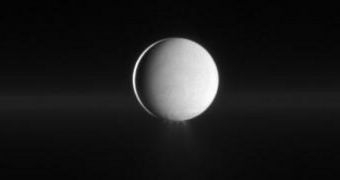Scientists at NASA announce that the Cassini spacecraft will do another flyby of the interesting Saturnine moon Enceladus today, August 13.
The target of the flight will be landscape features known as “tiger stripes,” which have made the moon famous around the world. They are located at Enceladus' southern regions.
The new flyby will not take the NASA probe too close to the moon. At the point of closest approach, the spacecraft will fly some 2,500 kilometers (1,600 miles) above its surface.
However, experts at NASA say that, in this instance, this high altitude is better than taking the orbiter too close to the moon.
They explain that, from such an altitude, the probe's composite infrared spectrometer instrument will be capable of conducting streamlined investigations, as in studies that cover the entirety of the tiger stripes formation.
The reason why the tiger stripes are so interesting is the fact that they apparently emit massive amounts of water and ice vapors from cracks in the ground.
This has made investigators assume that a liquid ocean may exist directly below the icy crusts making up Enceladus' visible surface.
However, confirming this idea proved to be an extremely difficult task, and one that required Cassini to conduct a large number of flybys.
The tiger stripes themselves are nothing but fissures in the ground, which act as vents for the water trapped underneath.
They spew out vapors and organic material high into the moon's atmosphere, reaching altitudes of several hundred kilometers. It is believed that these particles contribute to the formation of certain Saturnine rings.
Cassini revealed that some of the plumes reach far enough into space to merge with the planet's E ring, and add matter to it.
For the research, German investigators from the Max Planck Institutes for Nuclear Physics looked at data collected by a dust collector instrument aboard the spacecraft, and compared these readings with model data obtained through computer simulations
One of the things that makes Enceladus stand out from the crowd of Saturnine moons is the fact that astronomers believe it may house a liquid ocean.
Naturally, liquid water cannot endure in the frigid temperatures of its surface, but the experts say that it may be buried several kilometers, under a thick ice crust.
The Cassini orbiter is managed by experts at the NASA Jet Propulsion Laboratory (JPL), in Pasadena, California. Follow me on Twitter @TudorVieru

 14 DAY TRIAL //
14 DAY TRIAL //